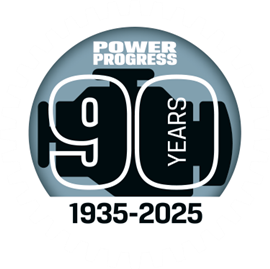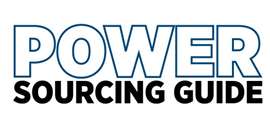Read this article in Français Deutsch Italiano Português Español
Electrification Yearbook: five trends shaping commercial transport
23 July 2025
If ACT Expo 2025 accomplished anything, it made clear that commercial vehicle electrification is advancing. However, OEMs and suppliers are no longer thinking in terms of a single propulsion answer. Instead, they seek an array of options that address specific duty cycles, vehicle range and total cost of ownership (TCO).
In its July 2025 issue, Power Progress documented many of these electrification developments in the 6th Annual Electrification Yearbook. They included everything from new battery chemistries to hydrogen refueling infrastructure. What follows are five trends from this most recent Yearbook that show where the industry is headed.
E-Axles Normalized
Integrated e-axles are becoming increasingly standard for battery-electric (BE) commercial vehicles. Volvo’s forthcoming VNL Electric truck, for instance, will feature an e-axle that integrates the motors and transmission in the rear axle, boosting range by freeing up space for additional batteries.
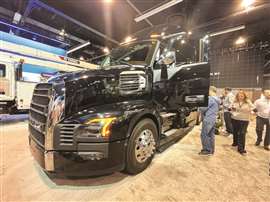 Mack Trucks debuted its Pioneer Class 8 on-highway vehicle plus announced it would be available in a battery-electric version. (Photo: Becky Schultz)
Mack Trucks debuted its Pioneer Class 8 on-highway vehicle plus announced it would be available in a battery-electric version. (Photo: Becky Schultz)
Additionally, Accelera by Cummins, which already includes e-axles in its broad portfolio of products, will put its fully integrated BE powertrain into Isuzu F-Series medium-duty trucks beginning in 2027. It will feature Accelera’s 14Xe e-axle equipped with the company’s Elfa motor and inverter.
Finally, the all-new Pioneer Class 8 truck from Mack Trucks will soon be produced in a BE version for regional haul, drayage and hub-and-spoke operations. The truck will feature Mack’s proprietary e-axle, which offers propulsion technologies allowing it to deliver 230 kW per axle.
Innovating Hybrid Solutions
Because full electrification isn’t right for every fleet application, many OEMs are implementing hybrid electric solutions. Harbinger and ReVolt Motors, for instance, are betting on hybrid architectures with internal combustion (IC) range extenders.
Harbinger’s medium-duty, plug-in stripped chassis offers about 500 miles of range with a gasoline-fueled range extender, which recharges the vehicle’s 140 or 175 kWh battery system from Panasonic Energy.
“Our hybrid is designed for use cases and routes that go beyond what an all-electric system typically supports,” said John Harris, co-founder and CEO of Harbinger.
By comparison, ReVolt is retrofitting existing trucks with a diesel-electric drivetrain. It gets 12 mpg for significant fuel savings while reducing emissions by 40 percent. Regenerative braking also tops off the batteries during operation.
In both cases, hybridization offers a bridge to electrification without the charging infrastructure risk.
Advent of Autonomy
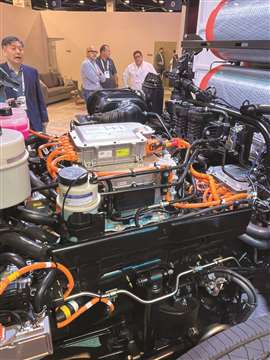 Hyundai Motor’s Xcient fuel cell Class 8 heavy-duty truck comes with this upgraded 180-kW hydrogen fuel cell system. (Photo: Becky Schultz)
Hyundai Motor’s Xcient fuel cell Class 8 heavy-duty truck comes with this upgraded 180-kW hydrogen fuel cell system. (Photo: Becky Schultz)
Autonomous commercial vehicles are steadily moving from concept to commercialization. For example, Hyundai Motors is working with AI autonomous trucking company Plus to bring together Class 8 FCEVs with autonomous software for long-haul operations. The partnership will see Plus’ SuperDrive solution paired with Hyundai’s Xcient truck.
Additionally, Volvo Trucks, via its Volvo Autonomous Solutions arm, has partnered with self-driving provider Aurora and AI autonomous driving company Waabi to commercialize self-driving Class 8 trucks.
The Aurora partnership has already resulted in Volvo’s VNL Autonomous truck participating in autonomous operations for DHL Supply Chain on regional routes in Texas. The Volvo truck employs Aurora Driver technology. While it is not yet electric, Volvo said the market will soon see the launch of its VNL Electric truck. Meanwhile, Volvo’s collaboration with Waabi will integrate Waabi Driver into VNL trucks.
Hydrogen Innovation Continues
The industry continues to embrace fuel cell electric vehicles (FCEV), with an eye for moving beyond the conceptual. Honda and Hyundai, for instance, appear to be actively commercializing fuel cell technology for heavy-duty applications.
At ACT Expo, Honda unveiled its next-generation fuel cell module aimed at reducing production costs while dramatically improving power density. The new module is aimed at FCEVs as well as stationary power and construction equipment applications.
Meanwhile, Hyundai showcased its Xcient Class 8 FCEV, which it described as the first mass-produced hydrogen-powered heavy-duty truck in the world. The company noted that many of its fuel cell electric trucks are already operating on regional routes in North America, thanks to strategic partnerships.
Fuel cell concepts still shared the spotlight, however. Honda brought back its Class 8 FCEV concept, first revealed at ACT Expo 2024. It also unveiled a stationary fuel cell power system aimed at powering sites such as factories and data centers, which is targeted for series production next year.
Redefining Infrastructure
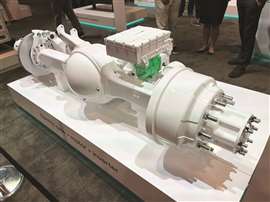 Accelera’s fully integrated battery-electric powertrain will be used in Isuzu F-Series medium-duty trucks for North America starting in 2027. (Photo: Becky Schultz)
Accelera’s fully integrated battery-electric powertrain will be used in Isuzu F-Series medium-duty trucks for North America starting in 2027. (Photo: Becky Schultz)
Charging remains a key aspect of EV infrastructure, particularly for commercial vehicles. However, BE infrastructure is evolving into ecosystems capable of providing a variety of services for fleets.
Accelera by Cummins, for instance, rolled out over-the-air (OTA) software updates starting with the school bus market. However, the company said the same framework has the potential to serve all its BE commercial vehicles.
Vehicle-to-grid (V2G) charging certification is another Accelera achievement. A nascent technology, V2G allows electric vehicles to both take power from and send power back to the grid. The result is improved grid stability during times of peak demand.
Finally, because of the innovation behind FCEVs, Hyundai is building out its own hydrogen production and fueling infrastructure. Working with Glovis America, Hyundai is supporting the HTWO Logistics initiative to decarbonize logistics around Hyundai Motor Group Metaplant America (HMGMA).
Editor’s Note: this story was written with the assistance of AI.
POWER SOURCING GUIDE
The trusted reference and buyer’s guide for 83 years
The original “desktop search engine,” guiding nearly 10,000 users in more than 90 countries it is the primary reference for specifications and details on all the components that go into engine systems.
Visit Now
STAY CONNECTED




Receive the information you need when you need it through our world-leading magazines, newsletters and daily briefings.
CONNECT WITH THE TEAM







